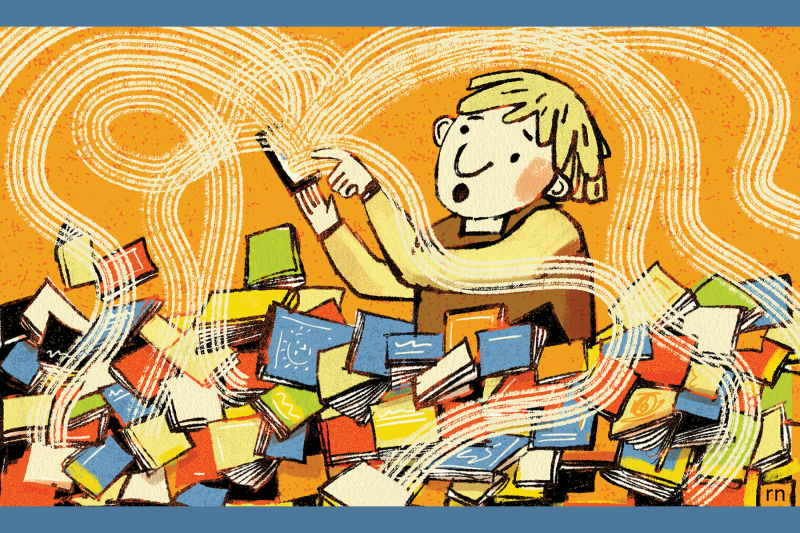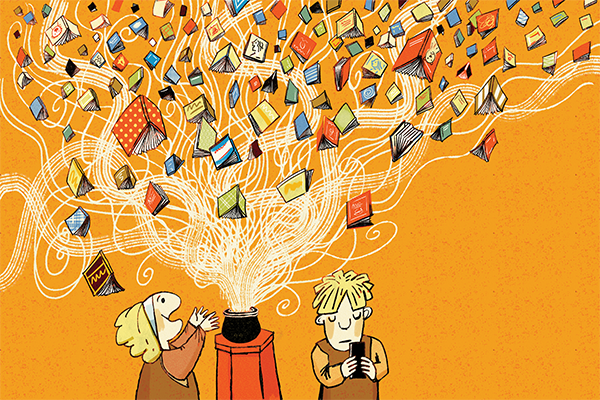IN STREGA NONA, author and illustrator Tomie dePaola’s most widely known picture book, an Italian witch has a magic pot that produces pasta on command with a song. Strega Nona is a town healer, concocting love potions and curing warts and headaches. In her old age, she hires a man named Big Anthony to help keep her home and garden. She assigns him a list of chores and warns him to never touch the pasta pot.
When Strega Nona leaves for a trip, Big Anthony ignores her warning and tries the spell for himself, singing, “Bubble, bubble, pasta pot, / Boil me some pasta, nice and hot, / I’m hungry and it’s time to sup, / Boil enough pasta to fill me up.” Out comes the pasta! Big Anthony invites everyone to eat, but once the village has had their fill, a horrifying reality sets in: Big Anthony doesn’t know how to stop the pot, and pasta overtakes the village. Just as the townspeople are about to be buried in pasta, Strega Nona returns. She blows three kisses to the pot, stopping the pasta and saving the town. The charming book ends with an image of a very full Big Anthony after having eaten the mess he’s made.
You may be familiar with the tale of Strega Nona; it comes from a long history of folktales. In 19th century Germany, it was known as “Sweet Porridge” and recorded by the Brothers Grimm. The story goes that a poor, hungry girl receives a pot that makes endless porridge. When the girl is away, her mother tries to use the pot and porridge floods the town. Just as the final house is about to be overtaken, the girl returns to say the magic words. Anyone wishing to return to the town had to eat their way back. In the Chinese folktale “The Water Mother,” it wasn’t a pot, but a pail of water that overflowed and created a stream that drowned the pail’s owner. All these tales might call to mind “The Sorcerer’s Apprentice,” made famous for some in Disney’s Fantasia. In that folktale, an apprentice, tired of doing his mentor’s chores, enchants a broom to do the work for him. The situation quickly gets out of hand, and he is driven to chop up the broom with an axe, but each new splintering creates a new broom. This continues until the sorcerer intercedes, then lectures his apprentice that only a master should invoke a powerful spirit.
Tomie dePaola, who was raised Catholic, saw folktales as an important part of passing on “one of life’s lessons” to a younger generation. But don’t take that to mean that he saw picture books as a way of indoctrinating children. “I never start out with an idea of moralizing when I do a book,” he shared with Sojourners in 1994. “It’s always, ‘I’ve got an idea for a story, is it a good story or isn’t it a good story?’” DePaola, who died in 2020, approached his work with a deep respect for children that not all adults share. “I’m convinced children know it when grown-ups talk down to them or attempt to give them propaganda,” he said. When Sojourners asked his thoughts on children’s publishing overall, dePaola expressed disappointment in people “doing children’s books who haven’t thought much about it. They just have ideas like ‘children like bright colors.’”
Feeding kids slop?
IT’S BEEN 50 years since dePaola published Strega Nona, and I doubt he could have imagined the turn children’s publishing has taken today. With the sudden rise of generative artificial intelligence, Amazon has been flooded with AI “slop”—cheap, slapped-together picture books written and illustrated entirely by AI. On Aug. 5 of this year, Google launched Gemini Storybook, an app that will create personalized stories for children, and even read them aloud if you like. The app has received harsh critique for poor story quality, lack of attention to child development, and even inappropriate illustrations. Author Martha Brockenbrough told Publishers Weekly that this and similar products “will result in children being fed lesser work at a time when their developing minds need the best we can give them.”
Amazon has been flooded with AI “slop”—cheap, slapped-together picture books written and illustrated entirely by AI.
I didn’t understand the work that went into making a picture book until I made one myself. The process is a complicated puzzle: illustrate a picture book that honors the author’s story, satisfies a publisher’s expectations, attracts a parent or adult, and ultimately resonates with a child. But beyond the editing, redraws, and general publishing process, I felt, for the first time, the weight of responsibility of delivering a quality picture book to kids. I thought of how meaningful my favorite books were to me growing up and only hoped that this one might mean something to a child out there.
I looked for inspiration from fellow picture book creators and elders in the art form, like dePaola, and found a teacher in Margaret Wise Brown, author of Goodnight Moon, one of the bestselling picture books of all time. Brown took writing for children very seriously. In her essay “Writing For Five Year Olds,” she begins by appreciating the developmental stages of a child from 2 to 5: how they love rhythm and pattern, their first attempts at humor and when they are just beginning to find the words to describe themselves and the world around them. Brown thought that to write for children you needed to care about them. Their challenges are very real ones. It wasn’t enough to know that children are delighted by trains, or dinosaurs, or horses. You need to know on some level why those things delight you. In “Creative Writing for Very Young Children,” she wrote:
A book should try to accomplish something more than just to repeat a child’s own experiences. One would hope rather to make a child laugh or feel clear and happy-headed as he follows a simple rhythm to its logical end, to jog him with the unexpected and comfort him with the familiar; and perhaps to lift him for a few moments from his own problems of shoe laces that won’t tie and busy parents and mysterious clock time into the world of a bug or a bear or a bee or a boy living in the timeless world of story.
All of this made 5-year-olds, for Brown, “a challenging age to write for.”
However, the myth persists that creating good books for children is simple. Children’s books are often treated as a cash grab, and with AI that has never seemed easier. But ChatGPT and other generative AI programs are not magic software that creates plots, story arcs, and character designs out of thin air. Behind the screen is a dark reality and with every prompt there’s a price.
McQuade feature mid.png

The flood is at our door
TO GENERATE AN image of a cat, AI must train on existing images of cats. The problem is that most AI software has been trained on copyright material, usually without permission. OpenAI, responding to an inquiry from U.K.’s House of Lords, confirmed that “it would be impossible to train today’s leading AI models without using copyrighted materials.” Copyright infringement might just sound like legal jargon, but it has real world consequences for artists. AI image generating platforms such as Midjourney openly encourage users to prompt the platform to mimic the art styles of specific artists. An article for the Center for Art Law describes how Midjourney’s CEO, David Holz, touted this capacity: “I think you’re all gonna get [your] mind blown by this style feature ... we were very liberal in building out the dictionary … it’s mostly artist names … 4000 artist names.”
Nashville-based Kelly McKernan was one of those artists. As was noted in a suit filed by McKernan and other artists against three AI companies, including Midjourney, it wasn’t long before the top internet search result for “Kelly McKernan” was not their artwork but an AI look-alike.
As generative AI becomes increasingly convincing—and perhaps as readers and viewers become less discerning of what is real and what is not—illustrators are being accused of secretly using AI. Many are posting time-lapse videos on their social media platforms to prove they are the creators of their own work.
“Is this the world now? Do I have to document every step of the creative process to prove I’m human?” wrote author and comic book artist Stephanie Stalvey on Instagram in response to a request that she “please boycott AI art.” “It’s bad enough [that] artists have to compete with tech that’s actively ripping us off and trying to replace us,” she continued. “Now we get accused of being AI?”
Generative AI also impacts the environment. It depends on massive data centers that require a tremendous amount of electricity and water to cool them. A New York Times article looked at the effects of a data center for Meta (the parent company of Instagram and Facebook) in Newton County, Ga. Some local residents suffered damage to their wells and plumbing during construction of the center. The county now faces potential water shortages and soaring water costs as the center, likely consuming as much as 500,000 gallons of water a day, has come on line and other companies seek to build centers nearby. According to The New York Times, “nine companies had applied to build data centers in Newton County, some asking for as much as six million gallons of water a day—more than the county’s entire daily use.”
What is your ease worth? The livelihood of an artist? The water from your neighbor’s faucet?
Stewarding our stories
AND THEN THERE are the consequences for human creativity and skill. AI is promising to give writers and artists a frictionless experience of creating. No longer will you have to suffer through writer’s block or lapses between promising ideas. Illustration styles won’t be developed over decades; they’ll be generated in seconds. To those creators, me included, I ask, “What is your ease worth?” The livelihood of an artist? The water from your neighbor’s faucet? What are you willing to sacrifice for the feeling of being better than you are?
These questions are even more pressing for the Christian who sees their creativity as a way to participate in the Divine. Our work does not just bear spiritual effects but can tangibly contribute to the liberation or oppression of our neighbor. Just because you personally do not feel the consequences of AI does not mean that it will not impact you. The flood is at your door too, and like the folktale warns, the mess we make will be ours to eat.
Today’s storytellers face new challenges, but their calling remains the same: to pass on life’s lessons. We may be in awe of the advancement of AI, but we must not forget that its “intelligence” is artificial. AI doesn’t know what it feels like to say goodbye to your mom and step into a preschool on your own for the first time. AI can’t tell you why hearing your dad do silly voices for the characters in your storybook is the funniest thing in the world. It doesn’t know how fun it is to play in the woods and how scary it is when you don’t know the way back home. It has never lost a tooth, struggled to tie shoes, or imagined being a ballet dancer. Maybe AI could tell you everything you’d ever want to know about trains, or dinosaurs, or horses, but it can’t tell you why they’re so cool. That’s the kind of stuff people know.
We don’t know where unregulated AI will take us and how much the world will change as it continues to integrate into our daily lives. The already undervalued work of children’s book creators might become even more difficult. Adults will need to be more discerning of the picture books they buy for the children in their lives. Those who care deeply about passing stories down from one generation to the next should consider their role in the fight for the rights of children. As AI continues to grow and infiltrate every aspect of our lives, I hope we heed the warning and wisdom of Strega Nona. The “pasta pot” is overflowing. It may promise to “feed us all,” but do we know how to turn it off?

Got something to say about what you're reading? We value your feedback!

